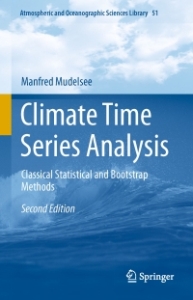Mudelsee M (2010) Climate Time Series Analysis: Classical Statistical and Bootstrap Methods. Springer, Dordrecht Heidelberg London New York. [ISBN-13: 978-90-481-9481-0, ISBN-10: 90-481-9481-4, e-ISBN: 978-90-481-9482-7, DOI: 10.1007/978-90-481-9482-7; xxxiv + 474 pp; Atmospheric and Oceanographic Sciences Library, Vol. 42]
Climate is a paradigm of a complex system. Analysing climate data is an exciting challenge, which is increased by non-normal distributional shape, serial dependence, uneven spacing and timescale uncertainties. This book presents bootstrap resampling as a computing-intensive method able to meet the challenge. It shows the bootstrap to perform reliably in the most important statistical estimation techniques: regression, spectral analysis, extreme values and correlation.
This book is written for climatologists and applied statisticians. It explains step by step the bootstrap algorithms (including novel adaptions) and methods for confidence interval construction. It tests the accuracy of the algorithms by means of Monte Carlo experiments. It analyses a large array of climate time series, giving a detailed account on the data and the associated climatological questions.
Contains 29 algorithms, 99 figures, 1135 references and 47 tables.
An excerpt from the Preface can be found at Climate Risk Analysis.
A large sample part (PDF) is here: Climate Time Series Analysis.
A small sample part is at Google Books.
